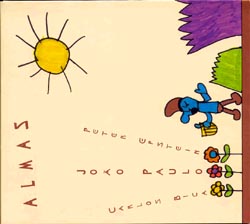 |
|||||||||
 |
|||||||||
 |
|||||||||
|
|||||||||
| The album Almas brings together Portuguese pianist João Paulo Esteves Da Silva, reed man Peter Epstein on soprano and alto sax and Carlos Bica on acoustic upright. Rather than a straight-ahead Jazz meet as the formation's trio grouping might suggest, this is a delicious mixture, of ECM-flavored Jan Garbarek/Keith Jarrett encounters -- dreamy lyricism, jazzy witticisms -- and the sophisticated, elegant salon-style instrumentals of Brazil - drawn-out melodic lines and surprising harmonic progressions. Devoid of high-speed chasers, Almas concentrates on moody atmospherics with hints of Satie's minimalist impressionism or boppily dancing while still moderate tempo trots rather than gallops. A cunning secondary title embedded in the actual's five letters hints further at such emphasis: Almas becomes Salam, the Muslim greeting for peace. The cover art by João's young son depicts a poet singing to the flowers and the sun, drawn spontaneously in response to the music. Add up these pointers and you'll rightly anticipate the piano's use to be predominantly bel canto, not percussive. This remains true also for the double bass which appears far more con arco than plucked, and the saxophone which favors cantabile delivery over pyrotechnics and aggressive vocal Jazz phrasing. This makes Almas into a modern form of chamber music, performed, incidentally, in Lisboa's Saint George British Anglican Church for an ideal ambience of spaciousness and just the right amount of reverb that extends decays without becoming muddy or overbearing. Mostly introspective and gentle, with great compositional richness and originality -- all tunes were composed by the pianist -- Almas is the kind of music that European soundtracks for story-based movies would fancy, except that the average length of seven minutes per track makes them unsuitable for all but the most elegiac of moving pictures. Alas, listening might well conjure up its own images, arising against a warm but slightly overcast sky, hence under muted shifty lighting, colors more faded than bright. Part and parcel of this label's mission is the use of a single pair of spaced omni mikes recorded straight to digital tape or DVD-RAM. Such purity and complete avoidance of compression limiters becomes a real boon for high-fidelity systems which can dig into the wealth of embedded spatial data to erect a virtual likeness of the recording venue in your listening space, for a very potent experience of temporary translocation. |
|||||||||
 |
|||||||||
 |
|||||||||